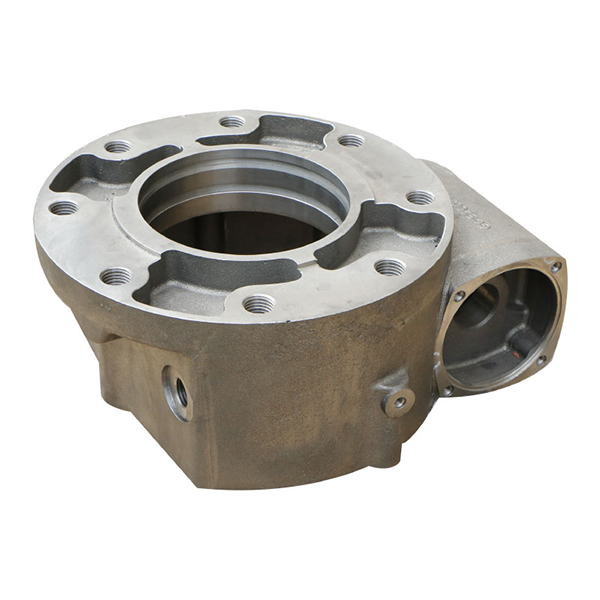
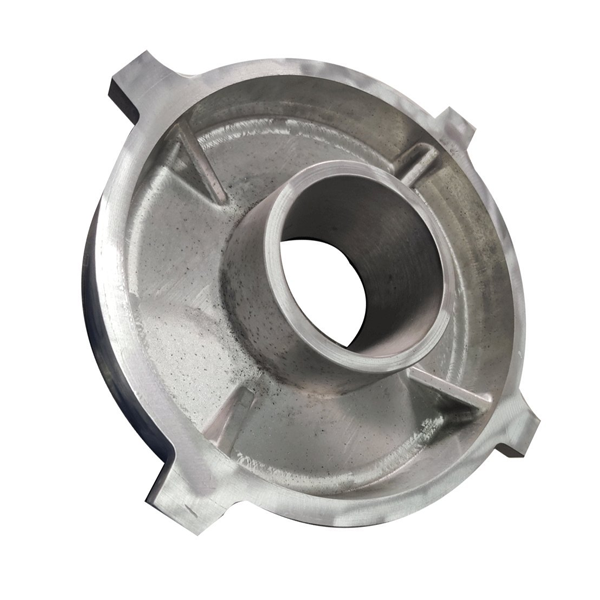
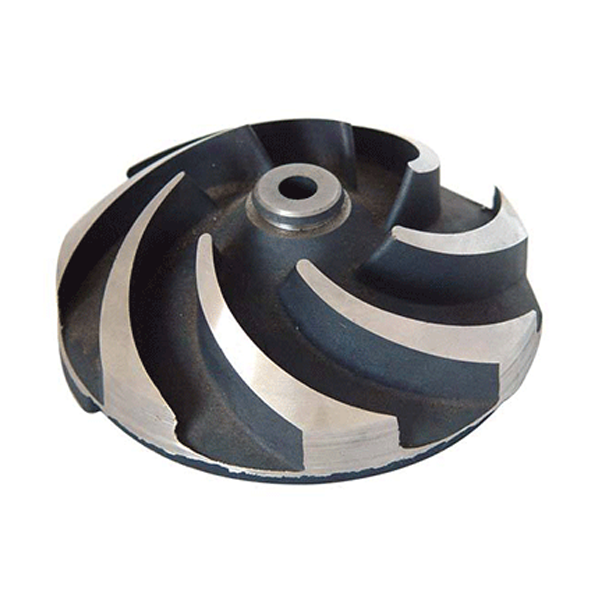
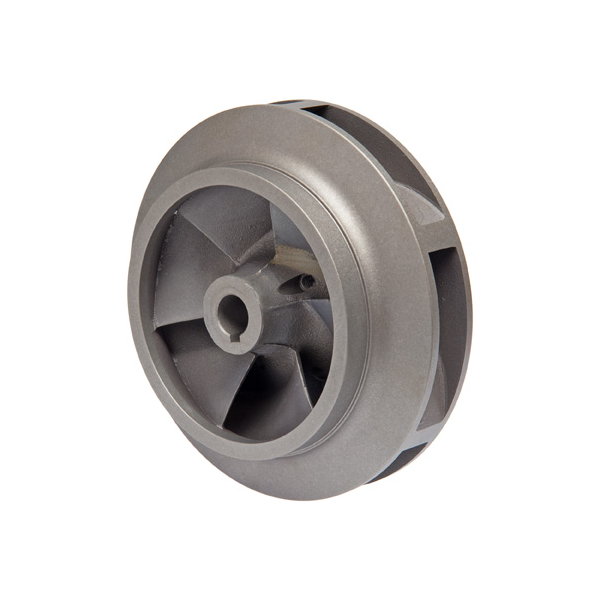
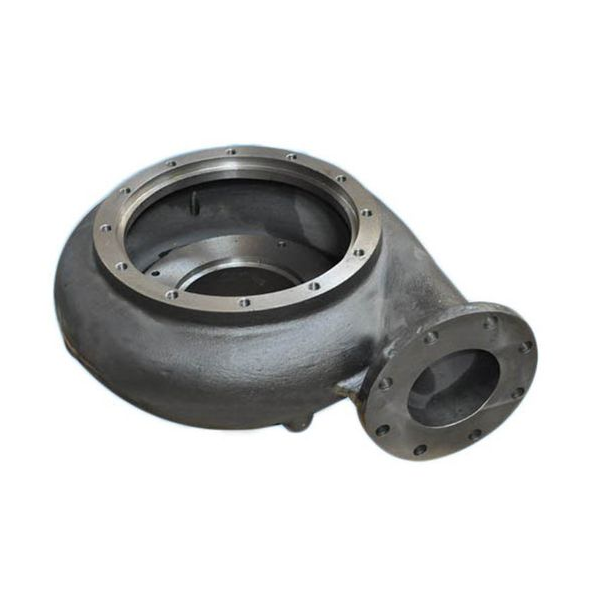
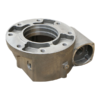
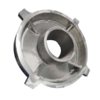
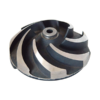
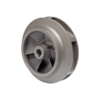
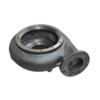
Jiangsu Shengrong produces a variety of water pump castings, the main components include pump casing, impeller, pump cover, bearing seat, inlet/outlet flange and other parts.Jiangsu Shengrong strictly selects materials, controls processes, designs structures and optimizes performance to ensure durability, efficiency and reliability.
Name: Cast iron pump casting
Material: Gray cast iron HT250/GG25
Standard/tollerance: EN1561-2011
Size and weight: OEM by drawing/40 days from mold to finished products
Advantages of Shengrong pump casting
1. High strength and durability
Material properties: cast iron (such as gray cast iron, ductile iron), stainless steel or bronze are usually used, with excellent mechanical strength and impact resistance, and can withstand high pressure, high-speed water flow and long-term operation wear.
Long life: The casting structure is stable, corrosion-resistant and fatigue-resistant, and suitable for harsh working conditions (such as sewage, seawater or chemical media).
2. Integrated molding of complex structures
Precision casting: Through casting processes (such as sand casting and investment casting), complex flow channels, impellers, volutes and other structures can be formed in one go, reducing the risk of leakage caused by welding or assembly.
Optimized fluid design: The smoothness of the inner wall of the casting is controllable, which can accurately match the hydraulic model and improve the efficiency of the water pump.
3. Cost-effectiveness
Economic efficiency of mass production: Casting is suitable for large-scale production, and the unit cost is lower than that of machined or welded parts.
High material utilization: Near-net shaping technology reduces the waste of raw materials and the amount of subsequent processing is small.
4. Design flexibility and customization
Adapt to various needs: castings of different sizes, pressure levels or special functions (such as anti-cavitation, wear-resistant coating) can be quickly realized through mold adjustment.
Integrated functions: installation holes, sealing grooves, etc. can be directly reserved in the casting to simplify assembly.
5. Good sealing
One-piece molding without welds: reduce leakage points, especially suitable for high-pressure water pumps, to ensure long-term sealing performance.
6. Corrosion resistance and adaptability
Wide selection of materials:
Ductile iron: rust-resistant, suitable for clean water and mildly corrosive media.
Stainless steel (304/316): acid, alkali, seawater resistant, used in chemical or marine environments.
Bronze: resistant to seawater corrosion, commonly used in ship water pumps.
7. Shock absorption and noise reduction
The damping characteristics of cast iron: can effectively absorb vibration and noise, and improve the smooth operation of water pumps.
Applications of pump casting
1. Agricultural applications
Irrigation and drainage: irrigation systems used in farmland and orchards, or to remove stagnant water
Sprinkler/drip irrigation systems: high-pressure water pumps provide power for water-saving agriculture.
Livestock water supply: provide drinking water for livestock or clean farms.
2. Industrial applications
Chemical industry: transport corrosive liquids (corrosion-resistant pumps are required, such as stainless steel pumps and fluorine-lined pumps).
Petroleum and energy: crude oil transportation, pipeline pressurization, cooling circulation systems (such as centrifugal pumps and screw pumps).
Pharmaceuticals and food: sanitary pumps (such as peristaltic pumps and centrifugal pumps) transport liquid medicines, beverages, dairy products, etc.
Power industry: boiler feed water pumps, cooling water circulation pumps (such as multi-stage centrifugal pumps).
Mining: mine drainage, slurry transportation (such as slurry pumps).
3. Municipal and construction
Water supply system: water plant pressurization, secondary water supply for high-rise buildings (such as multi-stage centrifugal pumps).
Sewage treatment: conveying sewage and sludge (such as submersible sewage pumps and screw pumps).
Fire protection system: fire pumps provide high-pressure water for fire fighting.
HVAC: circulating water pumps for hot and cold water circulation (such as pipeline pumps).
4. Household and commercial
Household water supply: booster pumps solve low water pressure problems, and submersible pumps are used for well water extraction.
Hot water circulation: circulating pumps for household water heaters or solar energy systems.
Gardens and waterscapes: small pumps for fountains and fish ponds.
5. Special applications
Ships and oceans: marine pumps (ballast pumps, seawater desalination pumps).
Medical equipment: blood pumps, dialysis machine pumps.
Emergency drainage: portable water pumps for flood control and rescue (such as diesel engine pumps).
Technical Capability
Advantages of Shengrong pump casting
1. High strength and durability
Material properties: cast iron (such as gray cast iron, ductile iron), stainless steel or bronze are usually used, with excellent mechanical strength and impact resistance, and can withstand high pressure, high-speed water flow and long-term operation wear.
Long life: The casting structure is stable, corrosion-resistant and fatigue-resistant, and suitable for harsh working conditions (such as sewage, seawater or chemical media).
2. Integrated molding of complex structures
Precision casting: Through casting processes (such as sand casting and investment casting), complex flow channels, impellers, volutes and other structures can be formed in one go, reducing the risk of leakage caused by welding or assembly.
Optimized fluid design: The smoothness of the inner wall of the casting is controllable, which can accurately match the hydraulic model and improve the efficiency of the water pump.
3. Cost-effectiveness
Economic efficiency of mass production: Casting is suitable for large-scale production, and the unit cost is lower than that of machined or welded parts.
High material utilization: Near-net shaping technology reduces the waste of raw materials and the amount of subsequent processing is small.
4. Design flexibility and customization
Adapt to various needs: castings of different sizes, pressure levels or special functions (such as anti-cavitation, wear-resistant coating) can be quickly realized through mold adjustment.
Integrated functions: installation holes, sealing grooves, etc. can be directly reserved in the casting to simplify assembly.
5. Good sealing
One-piece molding without welds: reduce leakage points, especially suitable for high-pressure water pumps, to ensure long-term sealing performance.
6. Corrosion resistance and adaptability
Wide selection of materials:
Ductile iron: rust-resistant, suitable for clean water and mildly corrosive media.
Stainless steel (304/316): acid, alkali, seawater resistant, used in chemical or marine environments.
Bronze: resistant to seawater corrosion, commonly used in ship water pumps.
7. Shock absorption and noise reduction
The damping characteristics of cast iron: can effectively absorb vibration and noise, and improve the smooth operation of water pumps.
Applications of pump casting
1. Agricultural applications
Irrigation and drainage: irrigation systems used in farmland and orchards, or to remove stagnant water
Sprinkler/drip irrigation systems: high-pressure water pumps provide power for water-saving agriculture.
Livestock water supply: provide drinking water for livestock or clean farms.
2. Industrial applications
Chemical industry: transport corrosive liquids (corrosion-resistant pumps are required, such as stainless steel pumps and fluorine-lined pumps).
Petroleum and energy: crude oil transportation, pipeline pressurization, cooling circulation systems (such as centrifugal pumps and screw pumps).
Pharmaceuticals and food: sanitary pumps (such as peristaltic pumps and centrifugal pumps) transport liquid medicines, beverages, dairy products, etc.
Power industry: boiler feed water pumps, cooling water circulation pumps (such as multi-stage centrifugal pumps).
Mining: mine drainage, slurry transportation (such as slurry pumps).
3. Municipal and construction
Water supply system: water plant pressurization, secondary water supply for high-rise buildings (such as multi-stage centrifugal pumps).
Sewage treatment: conveying sewage and sludge (such as submersible sewage pumps and screw pumps).
Fire protection system: fire pumps provide high-pressure water for fire fighting.
HVAC: circulating water pumps for hot and cold water circulation (such as pipeline pumps).
4. Household and commercial
Household water supply: booster pumps solve low water pressure problems, and submersible pumps are used for well water extraction.
Hot water circulation: circulating pumps for household water heaters or solar energy systems.
Gardens and waterscapes: small pumps for fountains and fish ponds.
5. Special applications
Ships and oceans: marine pumps (ballast pumps, seawater desalination pumps).
Medical equipment: blood pumps, dialysis machine pumps.
Emergency drainage: portable water pumps for flood control and rescue (such as diesel engine pumps).
Technical Capability

The production process of Shengrong pump castings mainly includes the following steps:
1. Design and mold preparation
Drawing design: Design the casting structure according to the performance requirements of the water pump (such as flow, pressure, corrosion resistance, etc.), determine the size, wall thickness, casting radius, etc.
Mold making: Usually a wooden mold, a metal mold (aluminum mold/steel mold) or a 3D printed sand mold is used to form the cavity of the casting.
2. Modeling and core making
Molding: Use molding sand (such as resin sand, water glass sand, etc.) to fill around the mold to form the outer shape of the casting (upper box and lower box).
Core making: Make sand cores (used to form the internal cavity of the casting, such as the water pump flow channel), and the sand cores need to have higher strength and high temperature resistance.
3. Melting and pouring
Melting: Melt the metal material (such as cast iron HT200, HT250, stainless steel CF8M, or bronze, etc.) into liquid in an electric furnace or cupola, control the composition (such as carbon and silicon content) and temperature (cast iron is about 1400-1500℃).
Pouring: Pour the molten metal into the mold cavity, and control the pouring speed and temperature to avoid defects such as pores and cold shuts.
4. Cooling and sand removal
Cooling: The casting cools naturally to a solid state in the mold, and the time depends on the wall thickness and material.
Sand removal: Remove the sand box and sand mold, take out the casting, and clean the surface sand by vibration or sandblasting.
5. Cleaning and post-processing
Remove the pouring and riser: Cut or grind the pouring system and riser.
Sandblasting/shot blasting: Clean the residual sand and oxide scale on the surface.
Welding repair: Repair surface defects (such as sand holes) (must meet the acceptance criteria).
6. Heat treatment (optional)
Annealing/normalizing: eliminate cast iron internal stress and improve mechanical properties.
Quenching + tempering: suitable for stainless steel or alloy steel castings that require high strength.
7. Machining
Turning/milling/drilling: machining key parts (such as flange end faces, shaft holes, sealing surfaces, etc.) to achieve drawing accuracy requirements.
8. Quality inspection
Appearance inspection: cracks, pores, shrinkage, etc.
Dimension inspection: caliper, three-coordinate measuring instrument, etc.
Non-destructive testing: X-ray, ultrasonic or penetrant testing (PT) to check internal defects.
Pressure test: water pressure or air pressure test on pressure-resistant parts.
9. Surface treatment and painting
Rust-proof treatment: spray anti-rust paint, galvanize or apply epoxy resin (especially for seawater pumps).
Marking: marking material, model and other information.
10. Finished product storage
After passing quality inspection, it is packaged and stored, waiting for assembly or shipment.
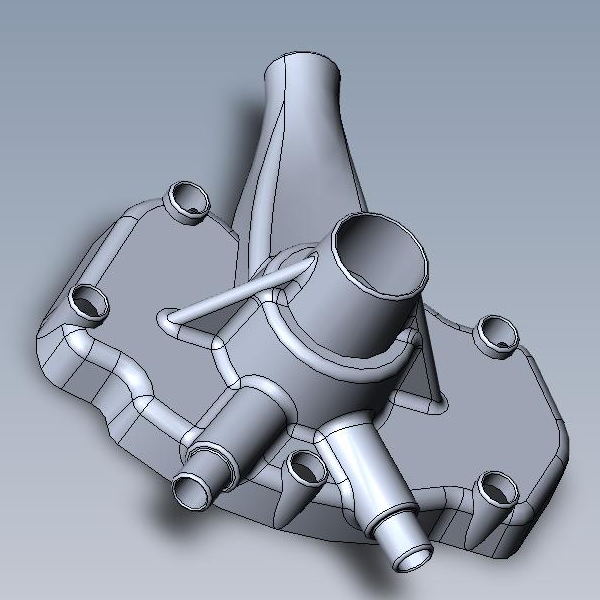
Process design and mold preparation
3D modeling and drawings: Design the shell 3D model according to the pump performance requirements, determine the parting surface, pouring system, riser and chiller position.
Mold making: wooden mold or metal mold (for sand mold), or wax mold (for investment casting)

Melting and pouring
Melting: cast iron (1400-1500℃), cast steel (above 1600℃), composition control (such as HT250 requires 3.2-3.5% carbon equivalent).
Pouring: molten steel is injected quickly and smoothly (avoid turbulent oxidation)
Cooling and sand removal
Vibration sand removal: remove molding sand to avoid mechanical damage.
Post-processing process
Cleaning: Shot peening to remove residual sand on the surface, cutting pouring risers (grinding wheel or gas cutting).

Key process requirements
Concentricity: The assembly runout of the impeller and the shaft is usually ≤0.05mm.
Pump body water pressure test (1.5 times the working pressure, pressure maintained for 10 minutes without leakage)
Optimize the impeller flow channel processing accuracy and reduce surface roughness.
Check the flatness of the sealing surface and use metal winding pads or O-rings.
Dynamic balancing correction (G6.3 grade standard), check the bearing seat size.
The milling center completes the rough and fine machining of the impeller in one clamping.
3D detection: Laser scanning and comparison of CAD models to ensure the accuracy of the profile

Dimension inspection: Check key dimensions with calipers, coordinate measuring machines, etc.
Appearance inspection: No defects such as cracks, pores, sand holes, etc.
Performance testing: Sampling for hardness testing, static balance/dynamic balance verification.
1: Advanced technology and equipment standards
Advanced technology: Sand casting, precision casting, and lost foam casting process. Casting sizes according to customer requirements, weights ranging from 0.5kg to 10,000kg
Automation equipment: Equipped with automated production lines, intelligent melting furnaces (medium frequency/high frequency induction furnaces),
Inspection equipment: Chemical composition/spectrometer and mechanical property inspection equipment, three-coordinate measuring machine (CMM), X-ray flaw detector, spectrometer, ultrasonic testing and other high-end quality inspection methods.
2:Quality management system
ISO 9001 (quality management system)
IATF 16949 (automotive industry quality management system, such as automotive parts)
ASTM/EN/JIS and other international material standards.
3:Customization capability
Customized production according to customer drawings, customers only need to pay half of the mold fee to develop new castings. The mold time is short, only 20 days, and the casting time only 10 days. Machining 10 days.
Free express sample to customers, mass production after customer samples are confirmed to be fully qualified. Our company does not require customers to place a minimum order quantity, satisfying customers with a variety of choices
4:Competitive prices
Our company’s prices are very competitive in the industry, and the specific price depends on the casting drawing and the customer’s order quantity. Welcome to inquire








Carbon, silicon, manganese, sulfur, phosphorus, chromium, nickel, copper and other elements

Tensile strength, yield strength, elongation, hardness, impact strength

Three-coordinate inspection, non-destructive testing, pressure testing, etc.

Every parts we will use anti-rust oil packing or primer, keep every parts in good condition after long time shipping.For small parts, we use wood box pallet packing.For bigger parts with pallet packing

Jiangsu Shengrong High end Equipment Manufacturing Industry Co., Ltd is a professional iron casting foundry about 26,000 square meters, Investment of 80 million yuan,include intermediate frequency furnace, new east Seoul horizontal line, cast star horizontal line, micro crystal automatic casting machine, 40T mixer and 20T mixer, core-making machine, shot blasting machine, machining center, inclined rail lathe, slot machine, vertical lathe, flat rail lathe and other equipment.Testing equipment:spectrometer, tensile testing machine, hardness tester, etc., and supporting chemical testing laboratories. Mainly engaged in: mechanical parts, auto parts, industrial pump parts, bearings and transmission parts manufacturing. Company’s main business: QT450-12, 500-7, 600-3 ball mill castings and HT250, HT300 gray iron castings and cast steel, stainless steel and other business, with the increase of business volume, the production is not only to meet the main business, while the product after the process of product processing business development, so that enterprises diversified production. Now the company has more than 100 employees, including a professional management team and new product development.
CONTACT
Get In Touch